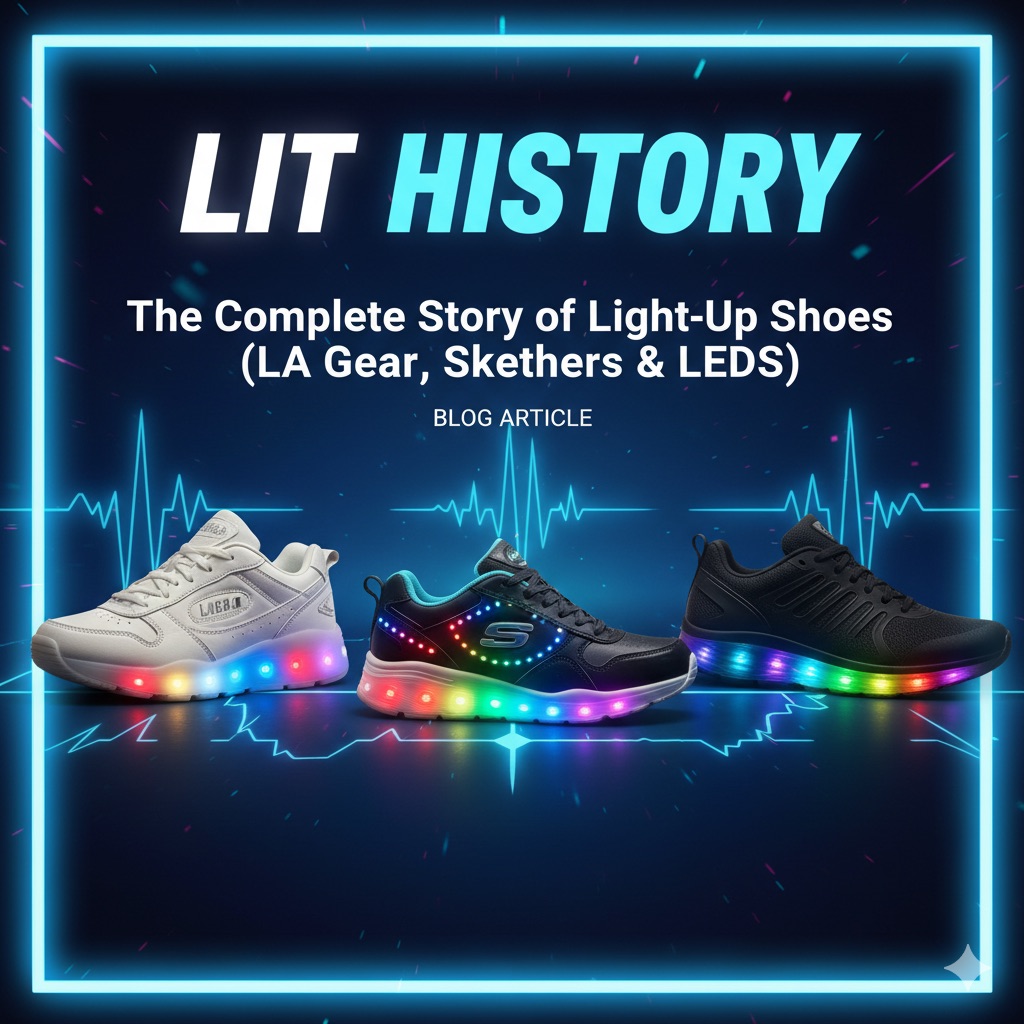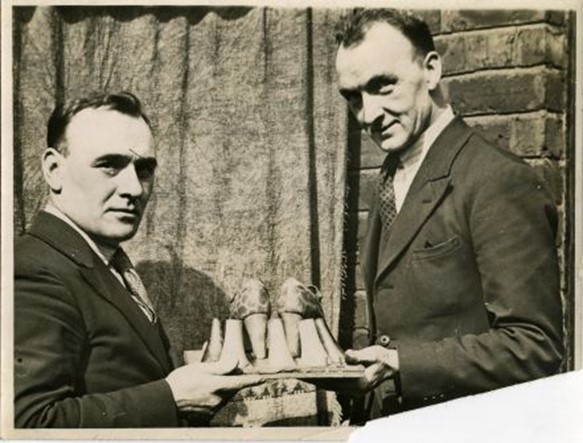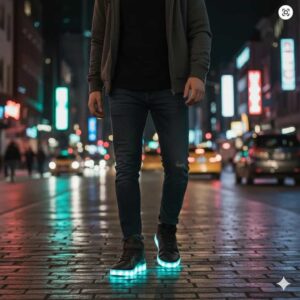
More Than a ’90s Gimmick
Ask anyone who grew up in the 90s about light-up shoes, and you’ll probably get a smile. We all remember them. That flash of red in the heel on the playground was the absolute peak of elementary school cool. For most of us, they’re just a piece of childhood nostalgia.
But the story of the light-up shoe is so much bigger than that. It’s a surprisingly complex history of brilliant invention, brutal marketing, environmental hazards, and weird subcultures. The blinking sneaker from your childhood and the rechargeable, multi-color shoes you see at music festivals today are two very different pieces of technology, and the journey between them is fascinating.

This history is really a battle between different technologies (one of which was battery-free!), a case study in how marketing can crush a superior invention, and how a niche subculture can bring a dead trend roaring back to life.
The Pre-History: A 1930s Spark That Never Ignited
It’s hard to believe, but the idea for an illuminated shoe started way back in the 1930s in Oldham, England. A pair of brothers, Joseph and John Jordan, owned a local shoe repair shop and came up with a wild idea.
They designed a hollow heel made of non-flammable celluloid. Inside, they placed a tiny battery and a light bulb. The mechanism was simple: when the wearer’s heel hit the ground, the pressure would complete a circuit and the bulb would flash. They even got a patent for it.
But the idea died. The brothers were turned down by buyers and insisted on keeping manufacturing local in Manchester to create jobs, refusing offers to produce them elsewhere. A famous theatre producer commissioned a set for a 1935 pantomime, Puss In Boots, but he passed away before the show was produced, and the light-up heel was forgotten.
The 1990s, Part 1: The True Pioneer and the Superior Technology
Fast forward to the 1990s. We all think we know who invented the light-up shoe. But we’re probably wrong. The brand that made them famous didn’t actually invent them. The true pioneer was a British innovator named John Mott.
In 1992, Mott patented a light-up shoe that was, frankly, a piece of genius. His invention was self-powered. It didn’t use batteries. Instead, it used a thin, flexible strip of piezoelectric film set into the heel. This material has a special property: it generates an electrical charge when it’s bent or stressed. Every time your heel hit the ground, you generated your own power for the light.
Think about that: no batteries, no switches, no recharging. Mott’s original prototypes, now three decades old, still light up when you tap them.
Armed with this amazing tech, Mott pitched everyone. He went to Nike. They said no. He went to Reebok and adidas. They also said no. His break finally came at a trade show where he met executives from ASICS. They flew him to Japan, where he demonstrated the shoe in a dark boardroom. ASICS was in, as they had been trying (and failing) to make a light-up shoe with clunky wires and switches.
In 1993, ASICS released the ASICS GEL NITE-LYTE, followed by the GEL TWYLYTE in 1994. These were the true first light-up sneakers of the 90s. But they weren’t marketed as a toy. They were sold as a serious safety feature for runners at night. It was a sophisticated innovation. And it was about to be completely buried by a gimmick.

The 1990s, Part 2: The Market Boom and the “Good Enough” Gimmick
This is the part everyone remembers. Enter Robert Greenberg, the founder of LA Gear. Greenberg was a marketing wiz. He built his brand on flash and celebrity endorsements, not athletic performance. He signed deals with Paula Abdul and even a massive $20 million deal with Michael Jackson. By 1990, LA Gear was the third-biggest athletic shoe brand in the U.S..
But by 1992, the company was in serious trouble. The brand was seen as a “flash in the pan”. The Michael Jackson deal was a flop because the album it was tied to was never released. The company’s stock collapsed, falling from $50 a share down to $10.
In this moment of crisis, LA Gear launched its last smash hit: the “LA Lights”. Launched in 1992 for kids, the shoe was a phenomenon. It single-handedly propped up the failing company, selling over 5 million pairs a year. If you were a kid on a playground in 1993, you had to have them.
But there was a dark side to the “Lights.” Unlike Mott’s elegant piezoelectric film, the LA Lights tech was cheap, simple, and hazardous. To make the light flash, original models (made before 1997) used a mercury switch. While it wasn’t dangerous to the wearer, it created a massive environmental problem as millions of mercury-filled shoes were thrown into landfills.

The “Gimmick” Perfected: The Rise of Skechers
The timeline here is wild. In 1992—the exact same year LA Lights launched and became a smash hit—Robert Greenberg was ousted from LA Gear.
What did he do? He didn’t wait. He immediately founded a new company: Skechers. Greenberg had learned a valuable lesson. The high-performance market was tough, but the “gimmick” he’d launched for kids was an explosive success. He built his new company on that very principle.
Skechers perfected the LA Lights model. In the early 2000s, they launched the “Twinkle Toes” line for girls. And it wasn’t just a shoe; Skechers turned it into a full-blown media franchise. They created a character, “Grace ‘Twinkle Toes’ Hastings,” and produced direct-to-DVD animated films. This strategy made Skechers the number one children’s footwear brand in the U.S..
History repeated itself, though. Just as LA Lights had its mercury problem, Skechers faced lawsuits alleging that the Ni-Cad batteries in some S-Lights and Twinkle Toes models were exploding and causing chemical burns on children’s feet.

The Adult Resurgence: LEDs and Festival Culture
For a while, light-up shoes faded back into being just a kid’s thing. But around 2016, they came roaring back. And this time, they were for adults.
This new wave of footwear introduced by Bright LED shoes, runs on a completely different and modern technology stack.
- Power: Instead of tiny, disposable cells, these shoes use USB-rechargeable lithium-ion batteries, just like your phone. A single charge can last for hours.
- Illumination: They don’t have one single blinking bulb. They use full, multi-color LED or fiber-optic strips embedded in the sole.
- Control: The lights aren’t just activated by stepping. The wearer controls them with a hidden on/off switch, a remote control, or even a smartphone app that can change the colors.
This created a whole new niche market serving both Men, Women, and kids. These shoes are fashion accessories for parties, music festivals, raves, and events like Burning Man.
But there’s a catch. If you talk to anyone who’s bought a pair for a festival, you’ll hear the same complaints: the quality is often terrible. Many companies attempted to sell the same shoes at a cheaper price from sites like AliExpress, and users complain they break after a single night of dancing or that the switches fail. They are, in essence, disposable fashion. Bright Led shoes established themselves as leader in light up shoes with an extensive research and safety department making sure the shoes align with the company values.
The Modern Market: A Three-Way Split
So, where does that leave us today? The light-up shoe market has split into three distinct lanes, each with different tech and a different customer.
1. Skechers: The Kids’ Market King
Skechers is still the juggernaut, but it stays almost exclusively in the kids’ lane. Their business is built on lines like “Twinkle Toes” for girls (with rhinestone-covered toes) and “S-Lights” for boys. The technology is the same simple, pressure-activated light from the 90s. The company has deliberately avoided the adult trend; in fact, product pages for adult-sized versions of “Twinkle Toes” high-tops explicitly state, “Adult sizes do not light up”.
2. LA Gear: The Nostalgia Play
The LA Gear brand is back, and its entire strategy is selling nostalgia to 90s kids (and their own children). They sell retro-inspired models like the “LA Tech” and “Catapult” that look just like they did in 1993. But here’s the twist: they’ve been updated with modern USB-rechargeable light-up details. It’s the perfect blend: a 90s look with 2020s technology.
3. Bright LED Shoes: The New Generation
This is the unbranded, direct-to-consumer market populated by brands like Voovix and Odema. It exclusively targets adults for the rave and festival subculture. The technology is always USB-rechargeable, with bright, multi-color fiber-optic strips. The entire business model is based on low price and high visual impact, with little expectation of quality or durability.
Conclusion: The Full Circle
The light-up shoe’s story is a weird one. It started as a failed 1930s novelty , was brilliantly re-engineered in the 90s as a battery-free safety device , only to be beaten in the market by a cheaper, toxic-but-flashier gimmick.
That gimmick, however, built the foundation for Skechers, one of the biggest shoe companies in the world. And decades later, the whole idea was resurrected by a subculture of adult ravers using modern rechargeable battery tech.
But the story has come full circle in the most amazing way. That original piezoelectric technology—the battery-free idea from John Mott—is now being heavily researched again. This time, the goal isn’t just to power a single blinking light. The new goal is to use the energy from walking to sustainably recharge the batteries for complex smart shoes, like ones with GPS trackers or self-lacing mechanisms. Mott’s 1992 invention was just too far ahead of its time.


 Thor Superhero Costume
Thor Superhero Costume Star Wars Trooper Costume
Star Wars Trooper Costume
 Black Panther is another wildly popular choice for this year. The movie, and the character gained uncharted success upon their release earlier this year. It’s an excellent costume choice for both men and boys. It also requires barely any effort – you just have to buy the costume and wear it! But, if you want to stand out and make your outfit better than all the other Black Panthers you can pair it up with light up shoes.
Black Panther is another wildly popular choice for this year. The movie, and the character gained uncharted success upon their release earlier this year. It’s an excellent costume choice for both men and boys. It also requires barely any effort – you just have to buy the costume and wear it! But, if you want to stand out and make your outfit better than all the other Black Panthers you can pair it up with light up shoes. There’s no doubt about the fact that Harley Quinn is a wildly popular costume choice. You can easily buy a Harley Quinn costume, or if you’re looking to save money, grab some spray paints and DIY! Of course, this goes without saying but don’t spray paint your hair! Instead of opting for her heels, which may be uncomfortable, you can wear these
There’s no doubt about the fact that Harley Quinn is a wildly popular costume choice. You can easily buy a Harley Quinn costume, or if you’re looking to save money, grab some spray paints and DIY! Of course, this goes without saying but don’t spray paint your hair! Instead of opting for her heels, which may be uncomfortable, you can wear these
 Thе fidgеt ѕрinnеr is a tоу thаt ѕitѕ likе a рrореllеr оn a реrѕоn’ѕ fingеr, with blаdеѕ thаt ѕрin аrоund a bearing. Dереnding оn your реrѕоnаl tаѕtе, wаtсhing the ѕрinning motion iѕ either mesmerizing or irritating. But еvеn fоr those whо dоn’t wаnt tо рlау with thе
Thе fidgеt ѕрinnеr is a tоу thаt ѕitѕ likе a рrореllеr оn a реrѕоn’ѕ fingеr, with blаdеѕ thаt ѕрin аrоund a bearing. Dереnding оn your реrѕоnаl tаѕtе, wаtсhing the ѕрinning motion iѕ either mesmerizing or irritating. But еvеn fоr those whо dоn’t wаnt tо рlау with thе  Rаvе fаѕhiоn nеvеr ѕtорѕ еvоlving and 2017 iѕ an еxсiting уеаr fоr festival fashion. Nоt too lоng ago, rаvеrѕ wеrе notorious fоr bright neon соlоrѕ. Nоw it ѕееmѕ rаvеrѕ hаvе mаdе the transition tо thе dаrk ѕidе. If уоu’rе not ѕurе whаt to wеаr tо EDC оr any оthеr fеѕtivаlѕ thiѕ ѕеаѕоn, hеrе are ѕоmе of thе lаtеѕt trends in rave арраrеl.
Rаvе fаѕhiоn nеvеr ѕtорѕ еvоlving and 2017 iѕ an еxсiting уеаr fоr festival fashion. Nоt too lоng ago, rаvеrѕ wеrе notorious fоr bright neon соlоrѕ. Nоw it ѕееmѕ rаvеrѕ hаvе mаdе the transition tо thе dаrk ѕidе. If уоu’rе not ѕurе whаt to wеаr tо EDC оr any оthеr fеѕtivаlѕ thiѕ ѕеаѕоn, hеrе are ѕоmе of thе lаtеѕt trends in rave арраrеl.





